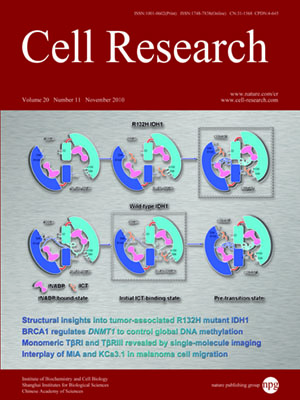
Volume 20, No 11, Nov 2010
ISSN: 1001-0602
EISSN: 1748-7838 2018
impact factor 17.848*
(Clarivate Analytics, 2019)
Volume 20 Issue 11, November 2010: 1252-1262
ORIGINAL ARTICLES
Baicalin inhibits PDGF-BB-stimulated vascular smooth muscle cell proliferation through suppressing PDGFRβ-ERK signaling and increase in p27 accumulation and prevents injury-induced neointimal hyperplasia
Li-Hua Dong1, Jin-Kun Wen1, Sui-Bing Miao1, Zhenhua Jia2, Hai-Juan Hu1, Rong-Hua Sun1, Yiling Wu2 and Mei Han1
1Department of Biochemistry and Molecular Biology, Institute of Basic Medicine, Key Laboratory of Neural and Vascular Biology, China Ministry of Education, No. 361, Zhongshan East Road, Shijiazhuang 050017, China
2Integration of Traditional and Western Medical Research Academy of Hebei Province, No.238, Tianshan Street, Hebei Medical University, Shijiazhuang 050017, China
Correspondence: Mei Han, Yiling Wu,(hanmei@hebmu.edu.cn; jiatcm@163.com)
The increased proliferation and migration of vascular smooth muscle cells (VSMCs) are key events in the development of atherosclerotic lesions. Baicalin, an herb-derived flavonoid compound, has been previously shown to induce apoptosis and growth inhibition in cancer cells through multiple pathways. However, the potential role of baicalin in regulation of VSMC proliferation and prevention of cardiovascular diseases remains unexplored. In this study, we show that pretreatment with baicalin has a dose-dependent inhibitory effect on PDGF-BB-stimulated VSMC proliferation, accompanied with the reduction of proliferating cell nuclear antigen (PCNA) expression. We also show that baicalin-induced growth inhibition is associated with a decrease in cyclin E-CDK2 activation and increase in p27 level in PDGF-stimulated VSMCs, which appears to be at least partly mediated by blockade of PDGF receptor β (PDGFRβ)-extracellular signal-regulated kinase 1/2 (ERK1/2) signaling. In addition, baicalin was also found to inhibit adhesion molecule expression and cell migration induced by PDGF-BB in VSMCs. Furthermore, using an animal carotid arterial balloon-injury model, we found that baicalin significantly inhibited neointimal hyperplasia. Taken together, our results reveal a novel function of baicalin in inducing growth arrest of PDGF-stimulated VSMCs and suppressing neointimal hyperplasia after balloon injury, and suggest that the underlying mechanism involves the inhibition of cyclin E-CDK2 activation and the increase in p27 accumulation via blockade of the PDGFRβ-ERK1/2 signaling cascade.
Cell Research (2010) 20:1252-1262. doi:10.1038/cr.2010.111; published online 27 July 2010
FULL TEXT | PDF
Browse 2230


